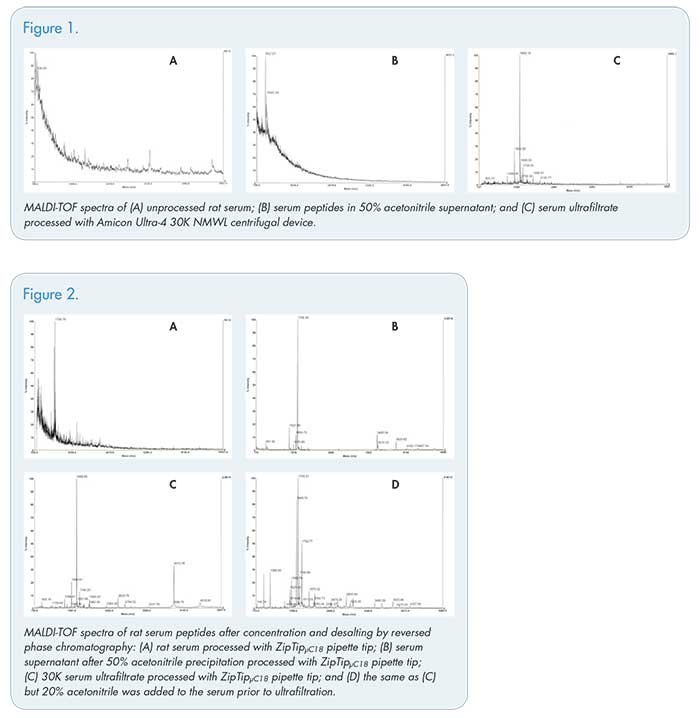Purification of Serum Peptides for MALDI Mass Spectrometry with Amicon® Ultra Centrifugal Filters
Biomarkers play an essential role in the drug discovery and development process. They provide powerful clues to genetic susceptibility, disease progression and drug response. Serum is a key source of putative protein biomarkers. One major impediment to discovering new biomarkers is the presence of salts, proteins and lipids in plasma or serum, which interferes with peptide analysis by mass spectrometry. Multiple protocols can be used to extract and enrich peptides from tissues and body fluids:
- After protein precipitation, fractionate by reversed-phase chromatography over C18 resin
- Acetonitrile precipitation of large proteins, while enhancing the solubility of smaller proteins and peptides
- Ultrafiltration for preparing low molecular weight fractions for biomarker analysis1–4
Ultrafiltration, in combination with solid phase extraction (SPE) on C18 resin is a convenient and efficient method for serum peptide purification. This approach provides more peptides for mass spectrometry analysis when compared to acetonitrile precipitation method. In addition, filter-aided sample preparation (FASP), which was originally developed using our Microcon® centrifugal filters5, has recently been optimized for use on Amicon® Ultra centrifugal filters6.
One advantage of FASP is that samples can be buffer-exchanged and concentrated through multiple spins without drying/precipitation concerns. Furthermore, FASP was adapted to 96-well plate format using our MultiScreen® Filter Plates7. Adaptation to the 96-well format permitted fast processing of biological material and opened possibilities of automating the FASP process in the future.
Methods
I. Preparation of Serum Peptides
- Dilute 1 to 4 mL of serum, plasma or cell lysate with 10% acetonitrile or with 10-20 mM tris HCL buffer pH 7.5 in a 1:1 ratio.
- Load the sample in Amicon® Ultra-4 10K NMWL centrifugal devices, and centrifuge in a swinging bucket rotor for 15-30 minutes at 3000 x g.
- Collect the filtrate.
- If sample contains acetonitrile, place it in a speed vacuum to evaporate the reagent; if not, continue directly with step 5.
- Acidify 10 μL of the filtrate sample using 5 μL of 1% TFA.
- Following the ZipTip® μC18 pipette tips protocol, desalt concentrate and clean the sample.
- Elute the sample directly onto a MALDI target with 2 μL of ∂-cyano-4-hydroxycinnamic acid matrix (5 mg/mL in 50% acetonitrile, 0.1% TFA). Note: If acetonitrile was added to the serum prior to the filtration, briefly centrifuge the samples in a Speed Vac® centrifuge to remove solvent before ZipTip® purification.
II. Peptide Analysis by Mass Spectrometry Using the Filtrate of Amicon® Ultra 4 mL 10kDa Centrifugal Ultrafilters
- Acidify peptide-containing ultrafiltrates from cell lysates or human serum with 1% TFA and concentrate on ZipTip® μC18 or ZipTip® strong cation exchange pipette tips following the procedure outlined in the user guide.
- Overlay the sample with 1 μL of ∂-cyano-4-hydroxycinnamic acid matrix (5 mg/mL in 50% acetonitrile, 0.1% TFA) and analyze on MALDI mass spectrometer.
III. Preparation of Serum Peptides by Acetonitrile Precipitation (Control Samples)
- Dilute the serum sample as indicated in the previous protocol I.1) by adding 10% acetonitrile in a 1:1 ratio (v:v),
- Load the sample in a 15 mL centrifuge tube and centrifuge the samples to precipitate the proteins.
- Collect the supernatant and place it in a speed-vac centrifuge to evaporate the acetonitrile.
- Resuspend the sample in 0.1% TFA, desalt and concentrate with ZipTip® μC18 pipette tips.
- Perform co-elution directly onto a MALDI target with 2 μL of ∂-cyano-4-hydroxycinnamic acid matrix (5 mg/mL in 50% acetonitrile, 0.1% TFA).
Results
Amicon® Ultra-4 30K NMWL centrifugal devices can be used for preparing serum peptides for analysis by high resolution mass spectrometry. When compared to unprocessed rat serum, data quality is improved after removing large proteins by acetonitrile precipitation (Figure 1A, B, below). The number and quality of MALDI-TOF detected peptide peaks was significantly improved using the ultrafiltered serum (Figure 1B, below).
Data quality was further improved by incorporating reverse phase chromatography in the sample preparation protocol, either alone, or in combination with acetonitrile precipitation and ultracentrifugation (Figure 2, below). Here, the ZipTip® μC18 pipette tip served as a convenient and efficient tool for micro-scale sample preparation prior to mass spectrometry. The highest signal, signal-to-noise ratio and number of detected peptides was achieved with samples prepared using all three methods (Figure 2D, below).
This approach can be used directly in combination with ZipTip® μC18 pipette tips for peptide identification by MS/MS, or as a first step prior to further surface-mediated enrichment using SELDI-TOF methods. These protocols may be applicable to other low molecular weight markers, such as drugs and metabolites.

To continue reading please sign in or create an account.
Don't Have An Account?